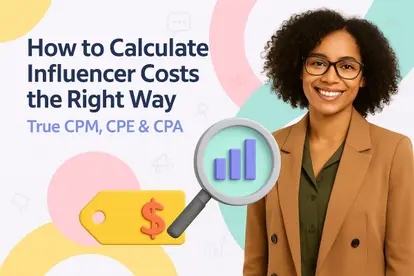In an era when influencer campaigns can deliver millions of impressions overnight, two questions loom large for agency and in-house marketers alike:
- Are you paying the right price for those impressions, engagements, and conversions?
- How can you move beyond gut-feel negotiations to a rigorously data-driven process?
Recent patterns show a growing demand for transparency; CPM rates that once hovered around broad averages now fluctuate from under $10 to well over $30 depending on niche, engagement quality, and platform.
On the other hand, CPE benchmarks reveal that smaller creators often carry CPEs up to 16× higher than macro talent, and CPA models require granular tracking to ensure each dollar spent translates into a valid acquisition.
As influencer marketing matures, the industry is shifting toward standardized formulas, tiered incentive structures, and unified cost calculators that speak the same language as paid-media teams.
This article will unpack true CPM, CPE, and CPA calculations, reveal emerging trends, and equip you with step-by-step frameworks to calculate influencer costs the right way.
Understanding Influencer CPM (Cost per Mille)
Cost per mille (CPM) remains the foundational currency for many influencer-awareness campaigns, yet misunderstandings around its calculation and interpretation can leave marketers overpaying or undervaluing inventory.
At its core, CPM measures how much a brand pays for each thousand impressions delivered by a creator, enabling apples-to-apples comparisons across channels and talent.
Calculating True Influencer CPM
- Aggregate a Consistent View Window. Select a window of recent posts—commonly the last 14 or 30 posts—to smooth out viral spikes and seasonal dips. Sum total views across that window.
- Derive the Creator’s Average Reach. Divide total views by the number of posts in your window. This yields the creator’s expected impressions per post under current engagement levels.
- Apply the Rate-to-Impression Ratio. Divide the negotiated flat fee or rate by the average impressions, then multiply by 1,000. The formula is:
This provides a normalized cost-per-thousand-impressions figure that can be benchmarked across creators, platforms, and paid media channels.
@neuralle When booking influencers it’s always smart to determine whether or not you’re getting value for views!!! #influencermarketing #cpm #influencerrates
Why a 14-Post Window Matters
Using a fixed recent-post window (e.g., 14 videos) limits distortion from one-off viral hits or low-performing posts. It ensures your “average” truly reflects the creator’s typical reach, as recommended by seasoned media buyers who caution against optimizing solely on single-post metrics.
Benchmark Ranges and Market Context
Across influencer campaigns, CPMs most often fall between $2 and $10 per thousand impressions.
Platform-Specific Influencer CPMs:
- Instagram: $5–$15 CPM
- TikTok: $3–$10 CPM
- YouTube: $10–$30 CPM
Outlier Signals:
- Sub-$5 CPMs are uncommon and may reflect introductory rates, special promotions, or inflated reach claims.
- CPMs above $30 typically indicate highly specialized niches, premium creator positioning, or additional deliverables and usage rights.
Paid-Social Comparisons:
- Facebook/Instagram Ads: Average paid social CPM on Meta’s platforms is approximately $8.96.
- TikTok Ads: Paid TikTok CPMs range from $3.20 to $10.
Interpretation: When an influencer CPM aligns with or exceeds these paid-social benchmarks, it underscores the value of earned media, particularly the authenticity and algorithmic boost that creator content can deliver.
Conversely, deals that undercut paid-social CPMs by a wide margin should be scrutinized for potential reach inflation or audience mismatch.
Strategic Implications for Agencies & Brands
- Value vs. Reach Trade-Off: A low CPM with minimal engagement or poor audience fit delivers weak brand impact. Always pair CPM analysis with engagement and audience-demographic data.
- Tiered CPM Clauses: Negotiate thresholds—e.g., $25 CPM for the first 100,000 impressions, $15 thereafter—to reward creators if content overperforms.
- Cross-Channel Comparison: Comparing influencer CPMs against paid social CPMs helps justify trade-offs. For instance, achieving 10 million organic impressions via creator content might represent a $144,000 value if purchased on Meta; this underlines the potential ROI of earned vs. paid media.
Avoiding Common Pitfalls
- Outlier Distortion: Excluding the highest and lowest one or two posts in your window can eliminate volatility if needed.
- Audience Quality Over Quantity: Tie CPM analysis to view-through rates, watch time, or brand lift studies to confirm that impressions translate into genuine attention.
- Holistic Measurement: CPM should feed into a broader metrics stack—combining CPE and CPA—to fully understand campaign performance across awareness, engagement, and conversion goals.
By rigorously applying a standardized CPM formula, benchmarking against paid media costs, and structuring performance-based clauses, marketers can transform influencer deals from black-box negotiations into data-driven investments.
Mastering Influencer CPE (Cost per Engagement)
Cost per engagement (CPE) quantifies what you pay for each meaningful interaction—likes, shares, comments, or saves—rather than passive impressions. When your objective is to maximize content resonance, social proof, or algorithmic reach, CPE offers a sharper lens than CPM.
Engagement encompasses any user action signaling active interest: likes/thumbs-ups, comments, shares/reposts, saves/bookmarks, or video completions. Brands may also count branded-hashtag uses or user-generated video responses under a campaign. Defining which actions to include upfront is critical to ensure consistent measurement.
True CPE Calculation
- Influencer Fee: Flat payment or retainer for content delivery.
- Total Engagement Actions: Sum of all defined engagements across agreed posts.
This formula gives you the dollar value per single engagement, enabling direct comparisons across creators regardless of audience size or platform.
Segmenting by Creator Role
Creators serve distinct funnel roles:
- Top-Funnel Storytellers: Drive awareness and affinity; expected high view counts but moderate engagement.
- Mid-Funnel Converters: Produce content optimized for click-throughs or swipe-ups; typically yield higher likes/shares per view.
- Long-Term Brand Ambassadors: Generate sustained, repeat engagement over a sequence of posts, often resulting in compounding social proof.
Mapping CPE targets to these roles ensures you set realistic benchmarks and briefs. For example, a macro influencer with 1 million followers may deliver 10,000 engagements for the same content that a micro-influencer with 50,000 followers yields 5,000 engagements—yet the macro creator’s CPE could be one-sixteenth of the micro’s, reflecting scale efficiencies.
Micro vs. Macro Efficiency
Data shows smaller influencers often command lower rates but have disproportionately higher CPEs—up to 16× the cost of larger creators. Conversely, macro talent may offer lower CPEs due to broader audiences and better algorithmic reach. Marketers should therefore model CPE curves across creator tiers to pinpoint the optimal balance between cost efficiency and niche relevance.
See this TikTok for reference:
@brendangahan Micro-influencers vs Macro-influencers: Which is the most effective influencer marketing technique? When it comes to influencer marketing, bigger isn’t better. Micro isn’t better. Better is better. Micro-influencers are touted as having: - higher engagement rates - lower pricing - more credibility In reality it is not that simple. Micro-influencers being more effective is not a universal marketing principle. There is the common misconception that micro-influencers are more engaging. While it is often true that micro-influencers have higher engagement rates than macro-influencers, that doesn’t mean they’re a more efficient cost per engagement (CPE) for advertisers. It is true that when influencers grow their engagement declines But, their costs don’t scale at the same rate. The average cost per engagement (CPE) is 16X higher for smaller influencers (2k-5k followers) than it is for larger ones (500k-1MM). Additionally, one factor that is often overlooked in working with influencers is the time spent to manage influencers. Working directly with an influencer that has 10 million subscribers is often just as much work as working with an influencer that has 10 thousand. Regardless, with influencer marketing there is no ‘one size fits all’. Few brands and marketers are willing to put in the time and effort to focus on identifying creators that are truly relevant. Instead, there’s an increasing reliance on marketplaces focused on scale. As the saying goes, the last mile is always the least crowded. None of this is rocket science, but like most good things, it takes patience, focus, and a long-term outlook vs looking for quick fix solutions. #influencermarketing #microinfluencers #macroinfluencers #macroinfluencer #microinfluencer
♬ Monkeys Spinning Monkeys - Kevin MacLeod & Kevin The Monkey
Contract Structures for Engagement
- Flat-Fee Plus Bonus: Guarantee a base payment, then add $0.10–$0.50 per engagement beyond a baseline threshold.
- Tiered CPE Rates: Negotiate descending CPEs as engagement volume increases: e.g., $1 per engagement for the first 5,000 actions, $0.80 thereafter.
- Engagement KPIs in Briefs: Explicitly state which engagement types count and require UTM or platform analytics screenshots for verification.
Optimizing for Lower CPE
- Creative Testing: A/B test CTAs, thumbnails, and captions to identify formats driving highest engagement rates.
- Audience Alignment: Prioritize creators whose audience demographics mirror your target customers—relevance drives affinity actions.
- Sequential Storytelling: Schedule follow-up posts or story series to re-engage audiences and capitalize on algorithmic momentum.
By precisely defining engagement, applying a consistent CPE formula, and tailoring deal structures to creator roles and performance tiers, agencies and in-house teams can elevate engagement from a vanity metric to a performance lever, ensuring every like, share, or comment is both measurable and aligned to broader campaign objectives.
Navigating Influencer CPA (Cost per Acquisition)
Cost per acquisition (CPA) measures how much an influencer campaign spends to secure a desired action—typically a sale, lead sign-up, or app install—from an influencer collaboration. For agency and in-house marketers focused on direct response outcomes, true CPA accounting reveals precisely which creator investments drive bottom-line results.
Before negotiating any CPA deal, agree on the exact “acquisition” event: a completed purchase of a specific product, an email subscription via a UTM-tagged landing page, or an app install validated through an SDK. Misalignment here leads to disputes over conversion credit and skews performance measurement.
True CPA Formula
- Total Campaign Spend includes all flat fees, bonus payouts, and performance incentives paid to the influencer.
- Verified Conversions are those tracked through unique links, codes, or pixel events directly attributable to the creator’s content.
Structuring CPA Partnerships
Revenue Share vs. Flat-Rate CPA:
- Revenue Share: Influencers receive a percentage (e.g., 10–20%) of each sale they drive. Aligns incentives tightly but requires robust e-commerce integration.
- Flat CPA: A fixed dollar amount per conversion (e.g., $5 per email sign-up). Easier to implement via coupon codes or affiliate platforms, yet may over- or under-compensate if baseline conversion rates fluctuate.
Tiered CPA Incentives:
- Establish escalating CPA rates: for example, $5 per conversion for the first 200 actions, $7 for 201–500, and $10 thereafter. This rewards overperformance and encourages influencers to optimize their content and distribution.
Hybrid Models:
- Combine flat fees (to cover production costs) with CPA bonuses. For instance, a $1,000 clip fee plus $8 per sale. This ensures influencers maintain quality standards while benefiting from upside.
Tracking and Attribution Best Practices
- Dedicated UTM Parameters: Assign each influencer a unique UTM string (e.g.,
utm_source=creatorName&utm_campaign=productLaunch). This isolates conversions in analytics. - Coupon or Discount Codes: Provide personalized codes to validate purchases offline or where pixel tracking is blocked.
- Affiliate Platforms: Use managed affiliate networks (e.g., Impact, Partnerize) to automate link generation, payment reconciliation, and fraud protection.
Mitigating Fraud and Invalid Conversions
Require a minimum basket value or quality threshold (e.g., sale must exceed $20) to qualify for CPA payouts, preventing trivial transactions from inflating metrics. Implement post-conversion hold periods (e.g., 7–14 days) to filter out cancellations and returns before commission calculation.
When CPA Excels—and When It Doesn’t
- Best Fit: Subscription services, software sign-ups, demo requests, or products with high margins where incremental customer lifetime value (LTV) justifies up-front CPA spending.
- Less Suitable: Brand-awareness campaigns or very low-price products (under $5) where CPA payouts may exceed profit margins.
Performance Optimization
- Creative Iteration: Analyze which content formats (unboxing, tutorial, testimonial) yield the lowest CPA and brief creators accordingly.
- Funnel Synergy: Layer CPA-driven creator ads into paid-social retargeting pools—use influencer audiences who clicked but did not convert, reducing effective CPA by focusing spend on warmer prospects.
- Long-Term Relationships: Repeat collaborations often drive lower CPAs as audiences grow familiar with the creator’s endorsement, reducing trust barriers and friction at checkout.
By defining clear acquisition events, structuring tiered and hybrid CPA agreements, and enforcing rigorous tracking protocols, marketers can confidently invest in influencer partnerships that measurably drive conversions and revenue.
Building a Unified Cost Calculator
A centralized cost calculator empowers agencies and brand teams to compare CPM, CPE, and CPA side by side, drive data-informed negotiations, and forecast campaign ROI.
By embedding standardized formulas into a dynamic Google Sheet or Excel workbook, you eliminate manual errors, accelerate decision-making, and ensure transparent reporting.
Key Inputs and Data Sources
- Influencer Fee: Flat payment or projected budgeted spend per creator.
- Average Impressions: Sum of recent post views ÷ number of posts (for CPM).
- Total Engagements: Aggregate of likes, comments, shares, and saves (for CPE).
- Verified Conversions: Count of tracked sales, sign-ups, or installs via UTMs or affiliate links (for CPA).
- Platform Benchmarks: Reference CPM/CPE/CPA market rates to flag outlier deals.
Sheet Structure and Formula Templates
Tab 1: Raw Data Entry
- Columns: Creator Name | Fee | Impressions Window Sum | # Posts | Engagements Sum | Conversions
Tab 2: CPM Calculation
- Average Impressions =
=Impressions Window Sum / # Posts - CPM =
=(Fee / Average Impressions) * 1000
Tab 3: CPE Calculation
- CPE =
=Fee / Engagements Sum
Tab 4: CPA Calculation
- CPA =
=Fee / Conversions
Tab 5: Summary Dashboard
- Display side-by-side tables of CPM, CPE, and CPA for each creator.
- Conditional formatting highlights metrics above or below benchmark thresholds.
- Sparklines visualize performance trends over time or across tiers (micro vs. macro).
Dynamic Benchmark References
- Create a hidden “Benchmarks” tab where agency analysts can update market CPM, CPE, and CPA ranges monthly.
- Use
VLOOKUPorINDEX/MATCHformulas to compare each creator’s metric against current benchmarks, flagging deals in red (above benchmark) or green (below).
Scenario Modeling
- Spend Adjustment Slider: Insert a cell with an adjustable total budget. Recalculate implied CPM, CPE, and CPA if fees change proportionally.
- Volume Projection: Incorporate a drop-down to model higher engagement (e.g., +10% engagements) or higher conversions (+15%) and instantly see impact on CPE and CPA.
Ensuring Data Integrity
- Protect formula cells to prevent accidental overwrites.
- Validate inputs with dropdown lists (platform names, creator tiers) and data-validation rules (numeric ranges).
- Document formula logic with inline comments or a separate “Instructions” tab for new team members.
Implementation Best Practices
- Monthly Updates: Schedule a recurring task to refresh raw data (views, engagements, conversions) and update benchmark rates.
- Stakeholder Access: Share view-only dashboard links with brand stakeholders, empowering them to track campaign health without altering calculations.
- Version Control: Maintain dated copies of the sheet to audit historical negotiations and performance.
By centralizing calculation logic into a living cost calculator, marketers gain instant visibility into which influencer investments deliver the most efficient impressions, engagements, and conversions—transforming fragmented spreadsheets into a strategic decision-support tool.
Turning Insights into Impact
Consolidating CPM, CPE, and CPA into a unified framework lays the groundwork for truly data-driven influencer strategies. Next, implement the cost calculator across your team, schedule monthly audits of real-time performance, and establish collaborative feedback loops with top creators.
Use tiered incentive structures and creative testing to drive continuous improvement, transforming one-off collaborations into scalable, high-ROI partnerships. By moving beyond gut-feel negotiations and towards strategic optimization, you’ll unlock sustainable growth and measurable impact across every stage of the funnel.
Frequently Asked Questions
What key metrics should I track to evaluate overall influencer campaign performance?
You should monitor reach (CPM), engagement rates (CPE), and conversions (CPA) alongside vanity metrics; integrating a comprehensive influencer marketing KPIs & metrics checklist ensures you cover both awareness and performance objectives.
How can I measure an influencer’s real-time impact on my website traffic?
Implement UTM-tagged links in creator posts and use an influencer analytics tool to attribute clicks and sessions directly back to each influencer’s content.
Which digital marketing KPIs complement influencer metrics for a holistic view?
Combine influencer metrics with digital marketing KPIs like bounce rate, session duration, and assisted conversions to assess how influencer-driven traffic engages with your broader site experience.
What’s the best way to optimize influencer briefs for higher engagement?
Use creator mood board techniques to visually align brand aesthetics and messaging, ensuring briefs resonate with both creators and their audiences.
How do I streamline influencer outreach to boost response rates?
Adopt an influencer outreach strategy that segments prospects by niche and engagement tier, personalizes your pitch, and leverages relationship-building touchpoints.
Which tools can help me track influencer ROI across platforms?
Consider influencer analytics services that aggregate performance data—impressions, engagements, and conversions—from TikTok, Instagram, and YouTube in one dashboard.
How should I adapt my influencer tactics for product launches vs. evergreen campaigns?
For launches, focus on high-touch unboxing and tutorial content as outlined in influencer marketing tactics; for evergreen, prioritize ongoing content partnerships and retargeting layers.
What’s the role of A/B testing in optimizing influencer content?
Testing variations of headlines, CTAs, or thumbnails—as detailed in optimize influencer marketing campaigns—reveals which creative elements drive the lowest CPE or CPA.
How do I integrate influencer activity into my broader digital strategy?
Align content calendars and performance benchmarks by syncing influencer outputs with your influencer marketing strategy roadmap, ensuring cohesive messaging across paid, owned, and earned channels.
Which metrics will show me how effective my influencer collaborations are over time?
Track longitudinal changes in CPM, CPE, and CPA, and compare them through a measure influencer campaigns framework to understand how relationship-building and repeated activations improve efficiency.




